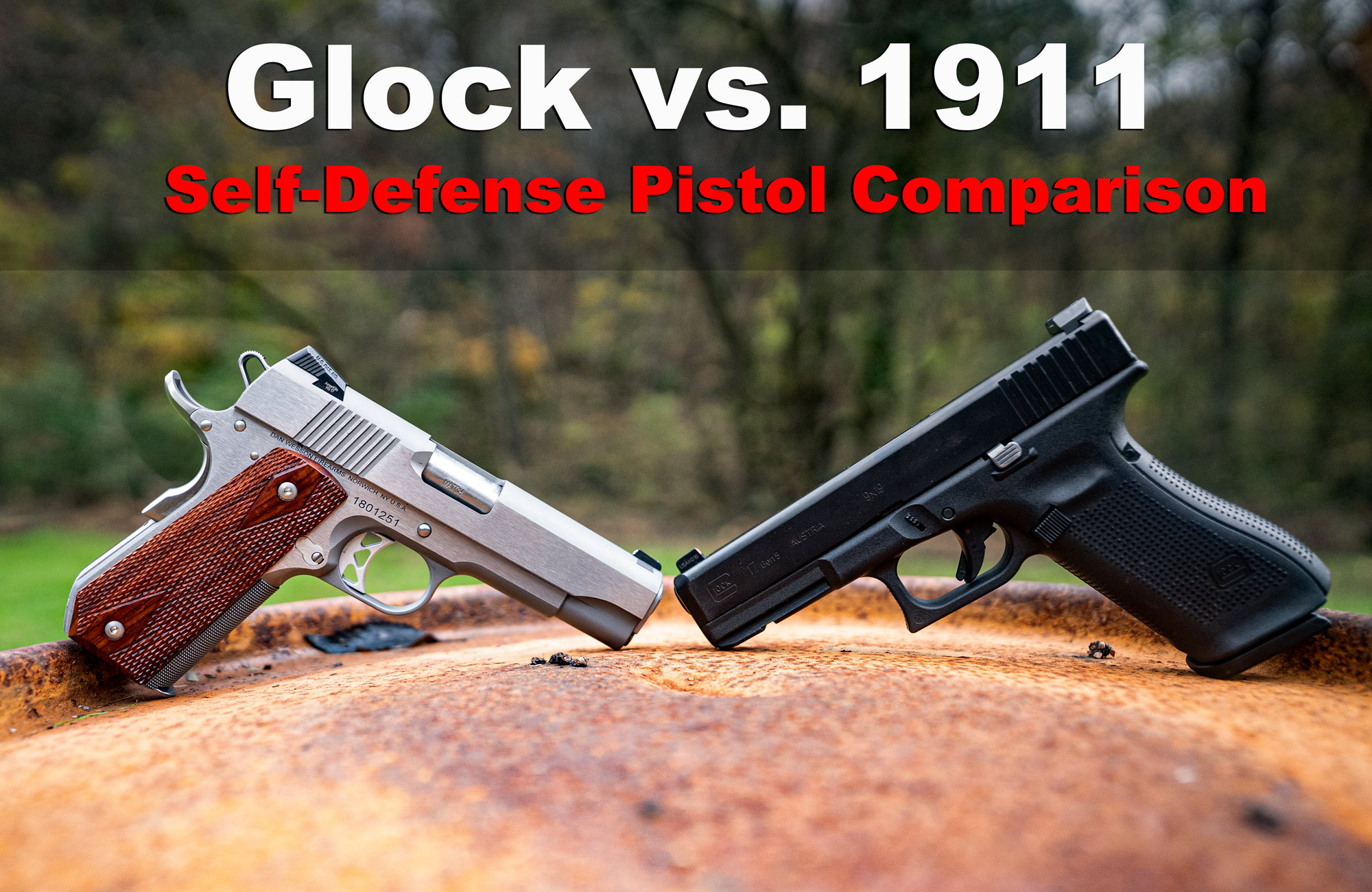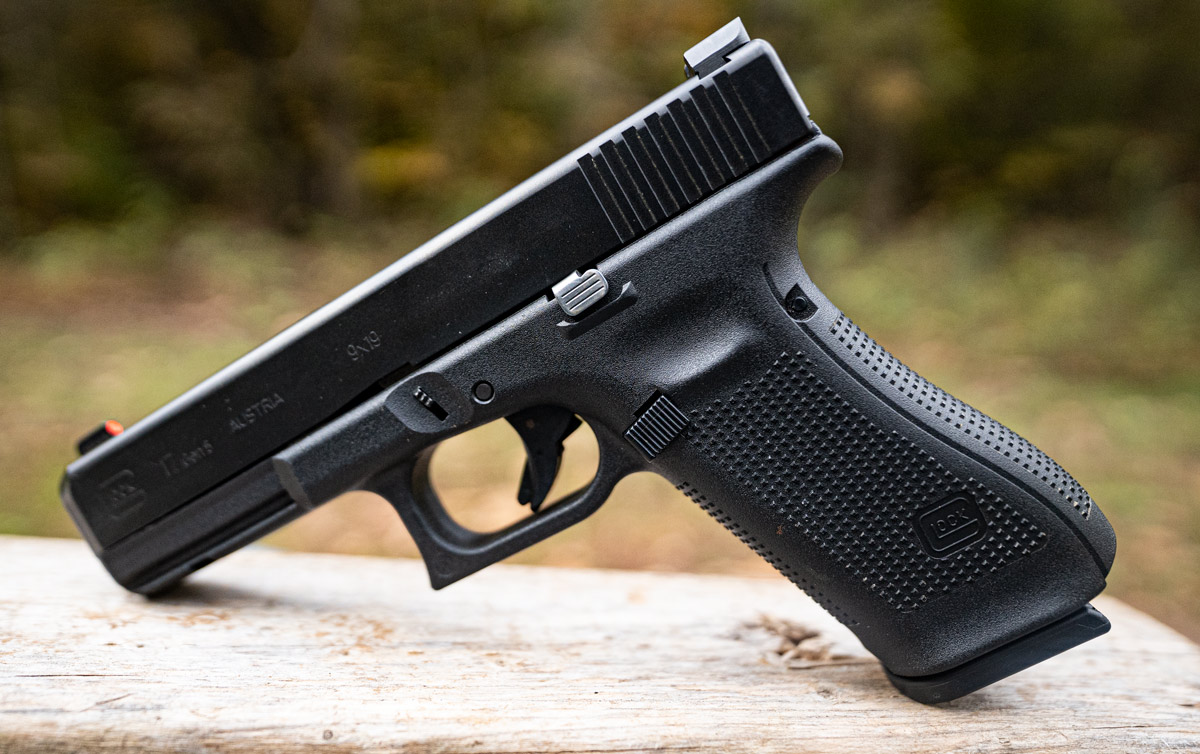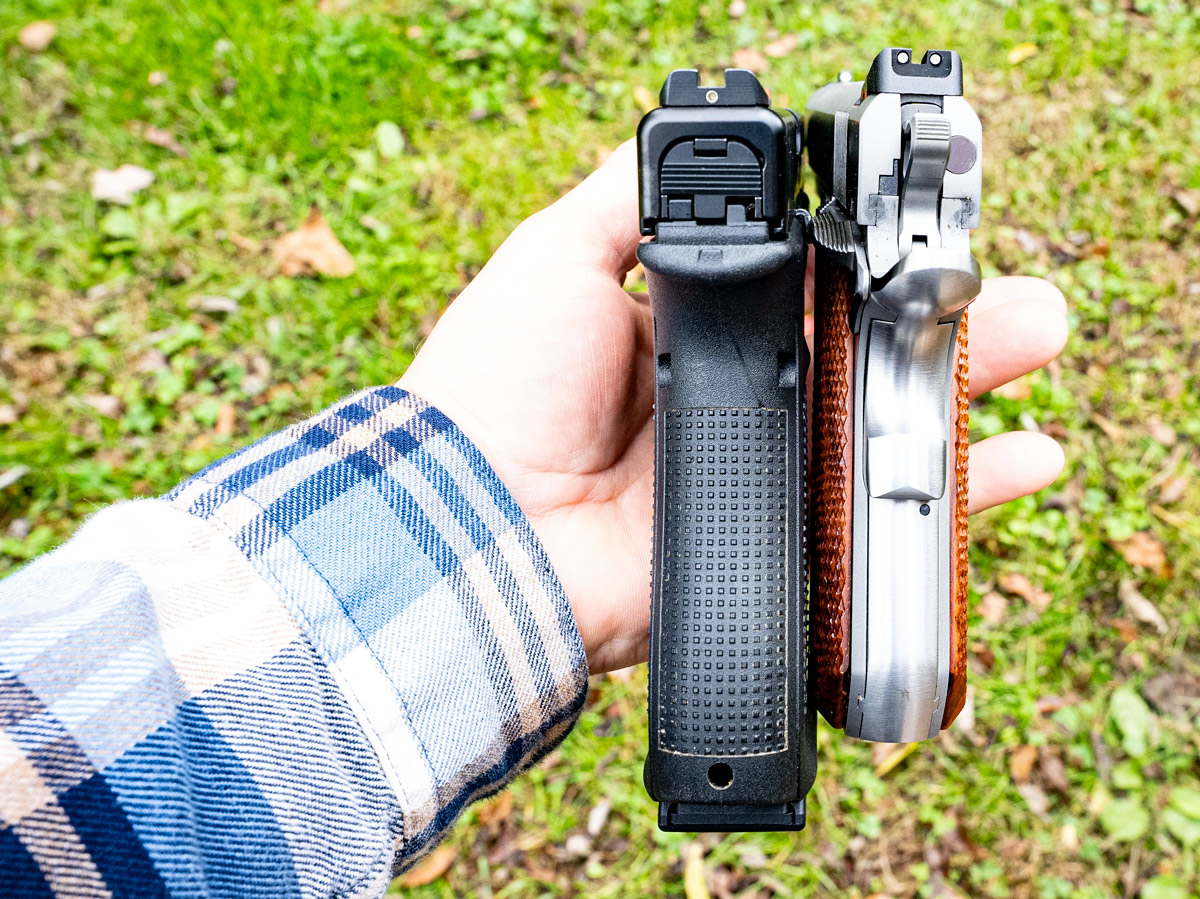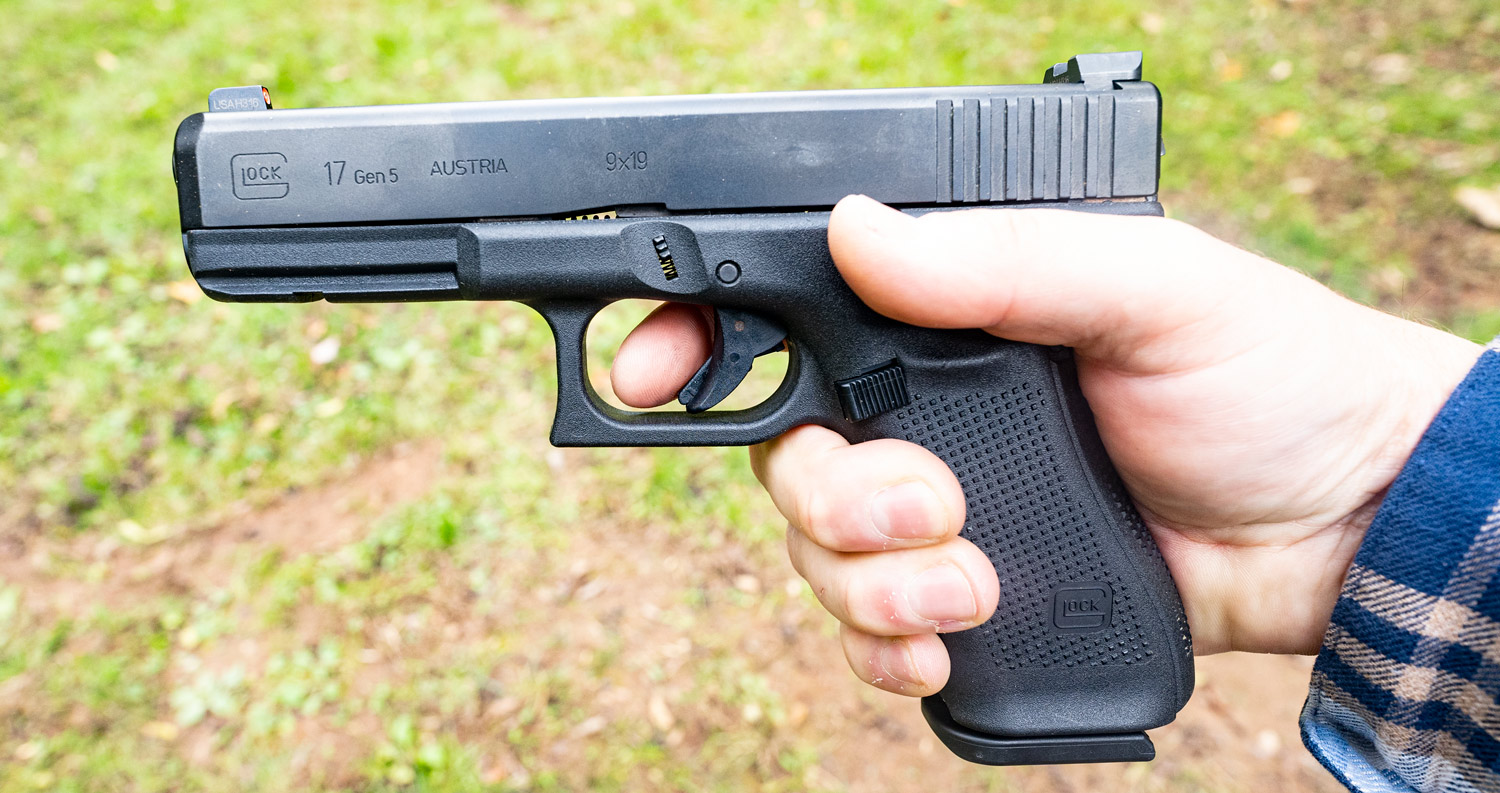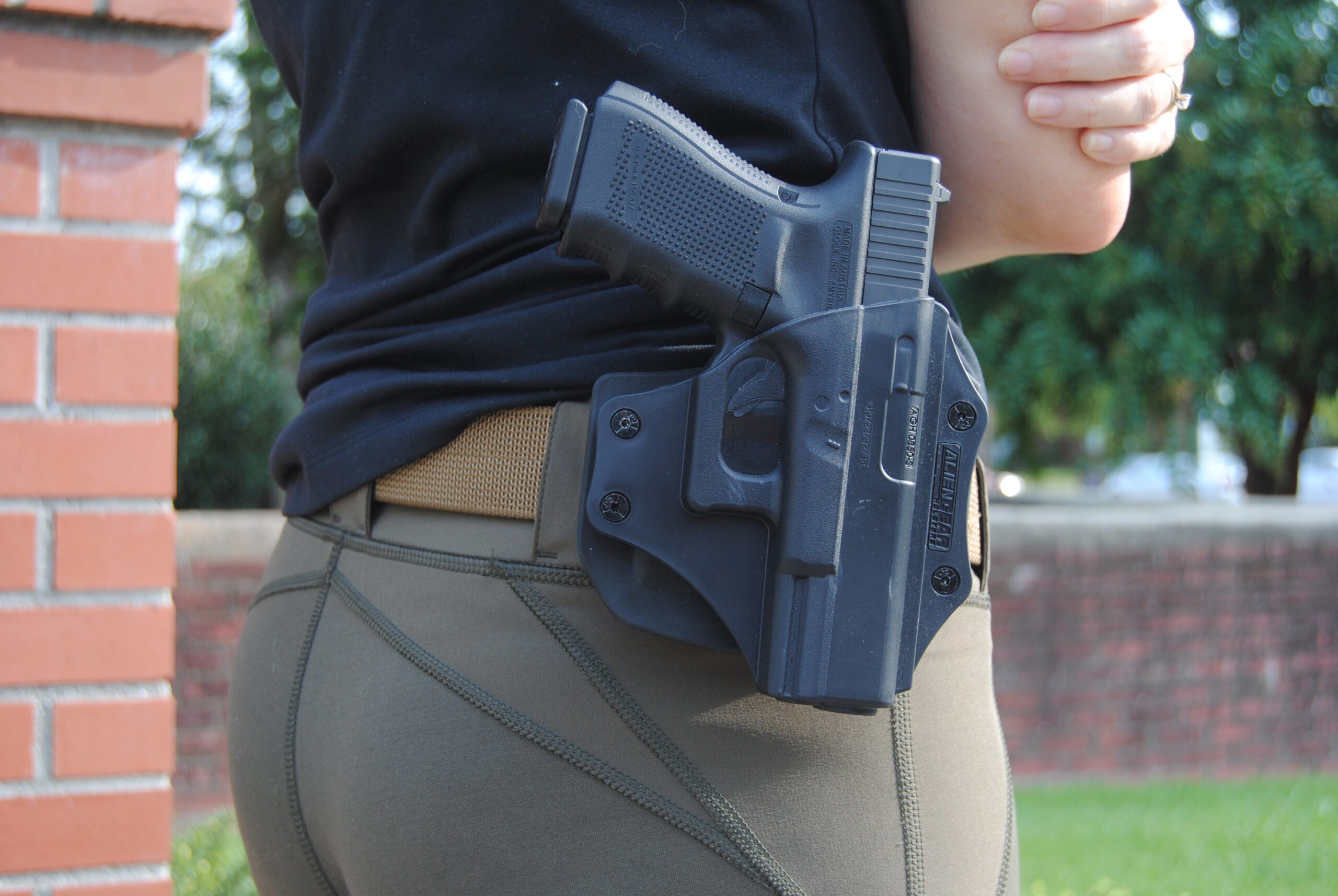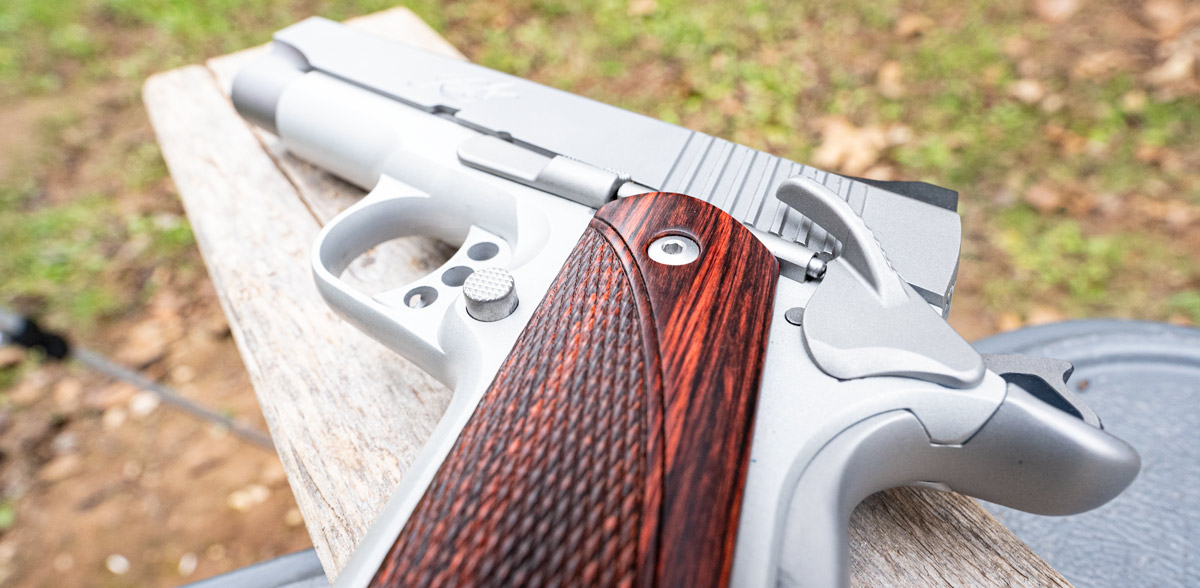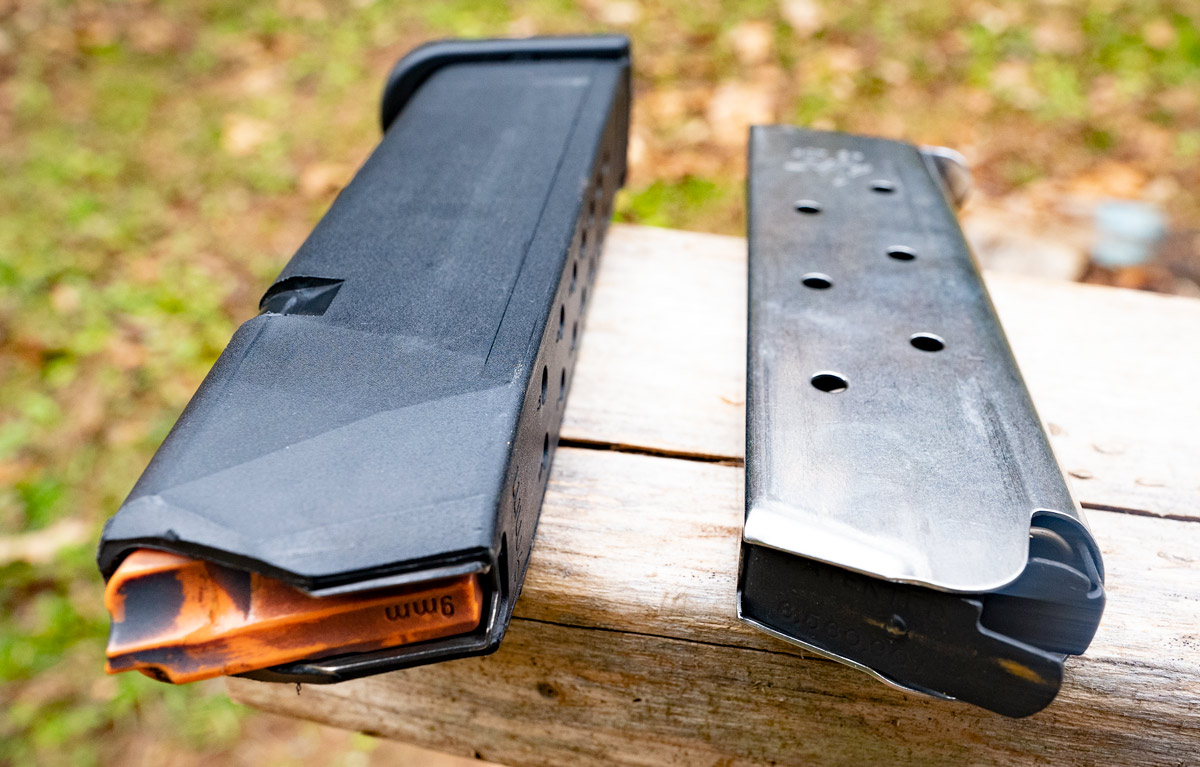A comparison of Glock vs 1911 pistols. What are the key differences and why might you choose one over the other for self-defense?
For the better part of a century, two weapons have set the bar for semi-automatic handguns – the Colt Model 1911 and the Glock 17. Although these two iconic pistols were designed more than 70 years apart, they have dominated duty and self-defense circles alike for decades. Even today, Glock vs 1911 debates reign supreme for good reason. The pistols remain the clear front-runners in an industry flooded with quality handguns.
Not only are these two legendary pistols insanely popular, they also have some of the most loyal, die hard fans on the face of the planet. Like good fans, these firearms aficionados argue the assets of their favorites on social media, internet forums, and at local gun ranges with clockwork regularity. Truly, the Glock vs 1911 showdown has become one of the hottest debates in the gun world. This is a rivalry big enough to put the Coke/Pepsi, Ford/Chevy, and Duke/Carolina rivalries to absolute shame.

Full disclosure: While I try really hard not to be a frothing-at-the-mouth Glock fan girl, I am far from impartial. While I think hitting targets with a 1911 is a great way to spend a range day, you’ll find me with a Glock 19 on my hip every other day of the week. I also drink Pepsi, drive a Chevy, and invested a bunch of money into a quality UNC education for my oldest daughter (which means I am obligated to root for Carolina while smack-talking Duke athletics).
Glock vs 1911: History
The Colt 1911
The 1911 has a long, rich history. Designed by the famous John Moses Browning, the 1911 was born in response to the US military’s need for a more effective sidearm. The previous military-issued weapon was the .38 revolver, which proved highly inadequate for close-quarters engagement in the Philippine-American War.
Ultimately, the .45 ACP cartridge was chosen to take on the opiate-crazed native tribesmen in the conflict. Several pistols chambered for the new hard-hitting cartridge competed for military contracts, but Browning’s auto-loading pistol, the Colt Model 1911, came out on top. It was officially approved by the United States Army just before World War I. The 1911 has been practically synonymous with .45 ACP ever since.
The US continued to use the 1911 through World War II, Korea, Vietnam, and most of the Cold War. It was eventually replaced by the current issue Beretta M9 in 1985. However, due to its proven history and huge popularity, the 1911 has never been completely phased out. Many of America’s elite fighting forces continue to charge into danger with a Colt 1911 by their sides.
The Glock 17
The Glock has an altogether different history. Where the 1911 was designed by the most famous firearms inventor of all time, the Glock was created by a simple curtain rod manufacturer. The company’s founder and lead engineer, Gaston Glock, had zero experience designing firearms. What he did have was an extensive background in advanced synthetic polymers. He used that expertise to develop the world’s first commercially successful line of polymer pistols.
In the early 1980s, Glock was seriously unsatisfied with the handgun options on the market. He borrowed proven mechanisms from previous pistol designs and combined them with synthetic materials and modern manufacturing technologies to produce the now iconic Glock 17. The pistol earned its name because it held the company’s 17th patent.
Glock managed to make a sidearm that was more durable, reliable, and easier to use than other pistols of the time. It was also incredibly lightweight and had a 17-round magazine capacity, which was significantly more than its peers. These traits won Glock a contract with the Austrian Army in 1982.
Today, more than two-thirds of America’s police departments use the Glock 17 as their standard-issue duty weapon. Also, the G17’s younger, and slightly more compact brother, the Glock 19, is arguably the most popular concealed carry weapon on the face of the planet.
Two Battle-Proven Pistols
Most 1911 groupies like to brag about how the 1911 “won two world wars”. Since their development, both pistols have served in multiple military conflicts around the globe. Although the 1911 is definitely the more battle-worn weapon, it only has more wartime on its resume because it’s been around longer than the Glock.
1911 vs Glock for Self-Defense
Battle experience aside, how do these two popular pistols compare in the civilian world? Let’s take a look at how effective the Glock and 1911 are for self defense.
Metal Versus Polymer
The biggest difference between the Glock and 1911 is their construction. The 1911 is made of steel, while the Glock is made from modern, nylon-filled polymer. Loyal subjects of the 1911 usually ridicule Glock pistols for being “made of plastic.”
However, the high-strength, nylon-based polymer invented by Gaston Glock (called Polymer 2) is nothing like cheap, brittle, stereotypical plastic. Not only is Polymer 2 lightweight (a fully-loaded.45-caliber Glock 21 actually weighs less than an unloaded, steel-framed 1911), polymer is also rust proof, impact resistant, and less affected by temperature. You can grip a polymer handgun without gloves in sub-zero temperatures as comfortably as you can in the scalding afternoon heat of a South Alabama summer. Plus, extreme temperatures have little to no effect on how the weapon functions.
Glock does use some steel components in their handguns. However, they use ferritic carburizing to protect those steel parts. When combined with the Glock’s signature polymer frame, their construction makes them practically immune to corrosion. They can also function reliably in some of the harshest conditions in the world.
Glock vs 1911’s “Knock Down Power”
Proponents of the 1911 often refer to the weapon’s “knock down power.” Knock down power is a bit of an ethereal concept, but 1911 fans are probably referring to the power of the .45 caliber rounds.
Honestly, 45 ACP ammo has no more “power” than 9mm Luger. Before you blow up the comments section, let me explain. It all comes down to physics. The equation for kinetic energy (or “power”) is:
KE = ½mv2
For our purposes, m is the mass of the projectile and v2 is the velocity of that projectile squared. (Don’t worry. I won’t make you do any computation. That would be cruel.)
Thanks to the magical powers of mathematics, we know that 9mm actually has more kinetic energy than .45 ACP. This may seem counterintuitive, but I promise it is true. Even though the 9mm projectile is lighter, it travels at a faster speed, resulting in more kinetic energy when it strikes the target.
If we’re talking about raw power, the 9mm wins. However, there is a lot more that goes into stopping a dangerous threat than the projectile’s kinetic energy. Ultimately, shot placement is where true “stopping power” lies.
Praising the 1911’s “superior” knock down power is mostly a way to justify the weapon’s limited seven-round magazine. Besides, the argument is relatively moot since shooters can trade in their Glock 19 for a Glock 21, 30, or 36…all of which are chambered for .45 ACP.
Accuracy
The Colt 1911 and Glock pistols are stock weapons designed more for reliability than precision accuracy. If you need a weapon that can handle snow, rain, mud, and dust without skipping a beat, either of these pistols is up to the task.
Both weapons are still inherently accurate and shoot comparable MOA at 25 yards. However, sometimes shooters have a harder time milking accuracy from one pistol or the other.
Accuracy and Trigger Pull
Many 1911 fans offer harsh criticism for the Glock’s factory trigger. Straight out of the box, the Glock’s trigger tends to be spongy and a tad on the heavy side. In comparison, the 1911’s trigger is relatively crisp and precise. These small differences in trigger pull can have big consequences for shot placement downrange. When it comes to accurate shooting, crisp beats mush every day of the week.
However, the Glock’s trigger is built that way on purpose. Its “Safe Action” trigger is a passive safety system. When you pull the trigger, three separate safety features are disengaged in succession. In other words, there’s a lot going on when you pull a Glock trigger.
The Glock’s trigger definitely isn’t match-grade, but you don’t need match-grade accuracy for self-defense. Hitting a human size target at self-defense distances (especially when the shooter is under duress) doesn’t require pinpoint accuracy or a competition trigger pull.
While you can always upgrade your trigger (and many Glock owners do), the stock trigger on a 1911 is consistently crisp and works slightly better for precision shooting than the Glock’s. However, both triggers are accurate enough for close-quarters shooting, which is what you need in a self-defense weapon.
Accuracy and Recoil
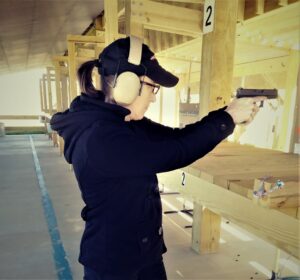
The 9mm recoil of a Glock 17 is fairly mild. However, if we’re comparing apples to apples, a fully-loaded Glock 21 (which is chambered for .45 ACP) weighs almost 10 ounces less than a loaded 1911 (38.8 ounces compared to 48 ounces). If we consider weight alone, the heavier 1911 should produce less felt recoil, allowing for faster shot recovery and more accurate follow-up shots.
However, things are a little more complicated than that. Because polymer has more flex than steel, some of that recoil gets soaked up by the polymer frame of the Glock pistol.
But before we call this one a draw, the 1911 has one more trick up its sleeve. The 1911’s grip is higher in relation to the bore centerline. With the higher grip, the 1911 actually produces less muzzle flip for a slightly faster second-shot response.
In the accuracy department, Glock fans should (reluctantly) concede defeat to the 1911. There’s a reason you’ll find more 1911s on the competition scene than you will Glocks. That being said, there are exceptions to every rule. Plenty of shooters claim there is no difference in recoil between the two weapons. Some shooters even claim they experience less recoil from their Glock 21 than their Colt 1911. There really is no one-size-fits-all handgun, no matter what the guys on those internet forums try to tell you. Ultimately, only you can decide which weapon performs better in your hands.
Comfort and Concealability
The dimensions of a Glock 17 are only slightly smaller than the Government frame 1911. Both are fairly large pistols, but neither was built for concealed carry. These full-size service pistols are more comfortably carried in a holster outside your clothing. You can certainly tuck them inside your waistband, but printing can be a major issue, especially for small-framed shooters.
Compared to the Glock, the 1911 is a weighty beast. At 39 ounces (with an empty magazine), the 1911 outweighs the Glock by more than a pound. The Glock’s lightweight design alone makes it far more suited for all-day carry. It’s just easier and more convenient to carry a lightweight weapon than a heavy, uncomfortable one. No one wants to walk around for lengthy periods of time with a pistol that tugs on your waistband and weighs down one hip. And we all know that a weapon worn on your person is a far more effective self-defense weapon than one left at home.
Safety Features of Glocks vs 1911s
There are some distinct safety feature differences that separate Glock vs 1911 pistols.
In fact, plenty of shooters criticize Glock for not having a manual safety. However, that doesn’t mean the Glock has no safety features at all. I already mentioned the Glock’s “Safe Action System.” Instead of manual safeties, Glock pistols have automatic safety mechanisms. When you pull the trigger, three passive, independently-operating mechanical safeties disengage so the weapon can fire. The mechanisms are then reset when you release the trigger.
The 1911 has two separate safety features that must be manipulated in order to fire the pistol. The first is the grip safety, which shooters naturally deactivate with a proper grip. The second safety feature is a manual safety that you have to push downward with the thumb before you can shoot.
Glock advocates claim its multiple manual safety features make the 1911 too complicated for defensive shooting. There are just too many things to remember to manipulate in a high-stress confrontation. Add in the body’s massive adrenal response which steals your fine motor skills, and a lot can go wrong in a self-defense situation.
Can negligent discharges happen with both weapons? Unfortunately, yes. However, those usually occur due to shooter carelessness, not design flaws in the weapon.
Personally, I like a self-defense weapon without a manual safety. If I draw my weapon in a real-world situation, that means things have already gone South and I’m ready to shoot my weapon. If I didn’t mean to shoot, that Glock would still be riding in my holster.
However, the manual safety features on the 1911 offer some shooters more peace of mind. If that describes you, then have at it.
Ammo Capacity
The standard .45-caliber Colt 1911 holds a 7-round magazine. (You can get 8 rounds in some aftermarket mags.)
In contrast, the 9mm Glock 17 features a 17-round magazine. (You can get replacement mags from Glock that hold a whopping 33 rounds.)
Even the .45-caliber Glock 21 holds thirteen rounds in the magazine.
While shot placement is arguably more important for threat elimination than shot count, most self-defense shooters prefer to hedge their bets. If you’re carrying a Glock 17 and the first shot misses its mark (or in some way fails to stop an attacker), you’ll still have 17 more rounds to send downrange. And since stress and adrenaline tend to degrade the shooting skills of even the most practiced shooters, I like those odds better than the 7+1 rounds of a 1911.
Customization
There is a ton of aftermarket support for both the 1911 and Glock pistols. From slides to grips to hammer and firing pin springs, shooters can customize nearly every element of both weapons. Aftermarket modding makes the 1911 and the Glock the Barbie dolls of the shooting world. Gun owners can customize and accessorize to their heart’s content, which has definitely contributed to the enduring popularity of both pistols.
Final Thoughts on Glock vs 1911
So which is better for self defense? The Glock or 1911?
This article certainly won’t settle this age-old debate. Besides, the whole 1911 versus Glock argument is mostly good-natured ribbing between gun guys (and gals). Kind of like the Ford vs Chevy squabbles. They are both great trucks and perfectly capable of dragging boats, pulling city slickers out of mud holes, or hauling a half cord of firewood. I will, however, mock your F-150 from behind the wheel of my Chevy Colorado while drinking a Pepsi and wearing my Carolina blue sweatshirt.
Just like we often root for our favorite pickups and sports teams, we also tend to cheer for our favorite sidearms.
That being said, I’ll gladly use my Glock to back you up while you reload your 1911. Because at the end of the day, we’re really all on the same team.
